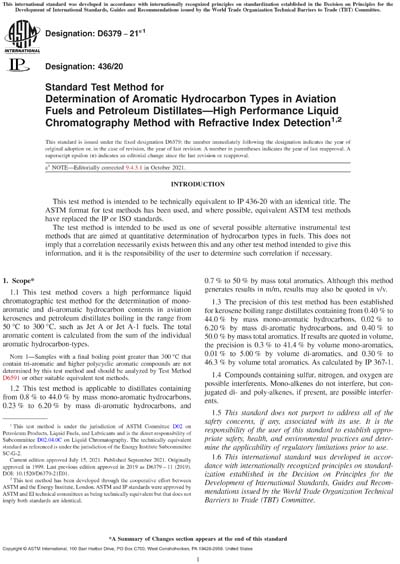Most recent
ASTM D6379-21e1
Standard Test Method for Determination of Aromatic Hydrocarbon Types in Aviation Fuels and Petroleum Distillates - High Performance Liquid Chromatography Method with Refractive Index Detection
1.1This test method covers a high performance liquid chromatographic test method for the determination of mono-aromatic and di-aromatic hydrocarbon contents in aviation kerosenes and petroleum distillates boiling in the range from 50 °C to 300 °C, such as Jet A or Jet A-1 fuels. The total aromatic content is calculated from the sum of the individual aromatic hydrocarbon-types.
Note 1:Samples with a final boiling point greater than 300 °C that contain tri-aromatic and higher polycyclic aromatic compounds are not determined by this test method and should be analyzed by Test Method D6591 or other suitable equivalent test methods.
1.2This test method is applicable to distillates containing from 0.8 % to 44.0 % by mass mono-aromatic hydrocarbons, 0.23 % to 6.20 % by mass di-aromatic hydrocarbons, and 0.7 % to 50 % by mass total aromatics. Although this method generates results in m/m, results may also be quoted in v/v.
1.3The precision of this test method has been established for kerosene boiling range distillates containing from 0.40 % to 44.0 % by mass mono-aromatic hydrocarbons, 0.02 % to 6.20 % by mass di-aromatic hydrocarbons, and 0.40 % to 50.0 % by mass total aromatics. If results are quoted in volume, the precision is 0.3 % to 41.4 % by volume mono-aromatics, 0.01 % to 5.00 % by volume di-aromatics, and 0.30 % to 46.3 % by volume total aromatics. As calculated by IP 367-1.
1.4Compounds containing sulfur, nitrogen, and oxygen are possible interferents. Mono-alkenes do not interfere, but conjugated di- and poly-alkenes, if present, are possible interferents.
1.5This standard does not purport to address all of the safety concerns, if any, associated with its use. It is the responsibility of the user of this standard to establish appropriate safety, health, and environmental practices and determine the applicability of regulatory limitations prior to use.
1.6This international standard was developed in accordance with internationally recognized principles on standardization established in the Decision on Principles for the Development of International Standards, Guides and Recommendations issued by the World Trade Organization Technical Barriers to Trade (TBT) Committee.
Content Provider
ASTM International [astm]






